
The heavy cruiser was a type of cruiser, a naval warship designed for long range and high speed, armed generally with naval guns of roughly 203 mm (8 inches) in calibre, whose design parameters were dictated by the Washington Naval Treaty of 1922 and the London Naval Treaty of 1930. The heavy cruiser is part of a lineage of ship design from 1915 through the early 1950s, although the term "heavy cruiser" only came into formal use in 1930. The heavy cruiser's immediate precursors were the light cruiser designs of the 1900s and 1910s, rather than the armoured cruisers of the years before 1905. When the armoured cruiser was supplanted by the battlecruiser, an intermediate ship type between this and the light cruiser was found to be needed—one larger and more powerful than the light cruisers of a potential enemy but not as large and expensive as the battlecruiser so as to be built in sufficient numbers to protect merchant ships and serve in a number of combat theatres.

The Pensacola class was a class of United States Navy heavy cruiser, the first "treaty cruisers" designed under the limitations set by the Washington Naval Treaty, which limited cruisers to a maximum of 10,000 long tons (10,160 t) displacement and a maximum main battery caliber of 8-inch (203 mm).

The New Orleans-class cruisers were a class of seven heavy cruisers built for the United States Navy (USN) in the 1930s.
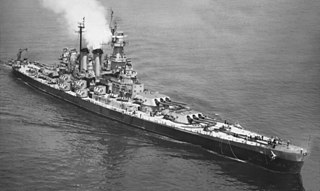
The North Carolina class were a pair of fast battleships, North Carolina and Washington, built for the United States Navy in the late 1930s and early 1940s.

The County class was a class of heavy cruisers built for the Royal Navy in the years between the First and Second World Wars. They were the first post-war cruisers constructed for the Royal Navy and were designed within the limits of the Washington Naval Treaty of 1922. Such ships, with a limit of 10,000 tons, standard displacement and 8-inch calibre main guns may be referred to as "treaty cruisers".

The Baltimore-class heavy cruisers were a large class of heavy cruisers in the United States Navy commissioned during and shortly after World War II. Fourteen Baltimores were completed, more than any other class of heavy cruiser, along with three ships of the Oregon City sub-class. The Baltimores also were the first cruisers in the US Navy to be designed without the limitations of the London Naval Treaty.

The Atlanta-class cruisers were eight United States Navy light cruisers which were designed as fast scout cruisers or flotilla leaders but which proved to be effective anti-aircraft cruisers during World War II. They were also known as the Atlanta-Oakland class. The Atlanta class had 12 x 5-inch (127 mm)/38 caliber guns, mounted in three superfiring sets of two-gun turrets fore and three more aft. The first four ships of the class also had an additional two twin 5-inch/38 waist mounts, one port and one starboard, giving these first four Atlanta-class cruisers the heaviest anti-aircraft armament of any cruiser of World War II. The last four ships of the class, starting with Oakland, had slightly different armament as they were further optimized for anti-aircraft fire.
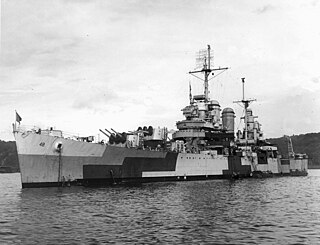
The Brooklyn-class cruiser was a class of nine light cruisers built for the United States Navy between 1935 and 1938. Armed with five triple 6-inch (152 mm) gun turrets, they mounted more main battery guns than any other standard US cruiser. The Brooklyn-class ships were all commissioned between 1937 and 1939, in the time between the start of the Second Sino-Japanese War and before the invasion of Poland. They served extensively in both the Pacific and Atlantic theaters during World War II.

The Portland class of heavy cruisers was a class of ships designed and constructed by the United States Navy in 1930. The two ships of the class, Portland and Indianapolis, saw extensive service during the Pacific War in World War II.

The Mogami class (最上型) was a ship class of four cruisers built for the Imperial Japanese Navy (IJN) during the 1930s. They were initially classified as light cruisers under the weight and armament restrictions of the London Naval Treaty. After Japan abrogated that agreement, all four ships were rearmed with larger guns and reclassified as heavy cruisers. All participated in World War II and were sunk.

The Fubuki-class destroyers were a class of twenty-four destroyers of the Imperial Japanese Navy. The Fubuki class has been described as the world's first modern destroyer. The Fubuki class set a new standard not only for Japanese vessels, but for destroyers around the world. They remained formidable opponents to the end of World War II, despite being much older than many of their adversaries.

The La Galissonnière-class cruisers were commissioned by the French Navy in the 1930s. They were the last French cruisers completed after 1935, until the completion of De Grasse in 1956. They are considered fast, reliable and successful light cruisers. Two cruisers of this class, Georges Leygues and Montcalm, took part in the defence of Dakar in late September 1940 during World War II. With the cruiser Gloire, they joined the Allied forces after the successful Allied landings in North Africa in November 1942. The three other cruisers of the La Galissonière class, held under Vichy control at Toulon, were scuttled on 27 November 1942.

The Duquesne-class cruiser was a group of two heavy cruisers built for the French Navy in the mid 1920s, the first such vessels built for the French fleet. The two ships in the class were the Duquesne and Tourville.
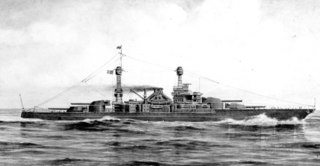
The first South Dakota class was a group of six battleships that were laid down in 1920 for the U.S. Navy, but were never completed; designed to achieve 23 knots, they represented an attempt to catch up with the increasing fleet speeds of its main rivals, the British Royal Navy and Imperial Japanese Navy.

The 6-inch/47 caliber Mark 16 gun was used in the main batteries of several pre-war and World War II US Navy light cruisers. They were primarily mounted in triple turrets and used against surface targets. The Mark 16DP gun was a dual purpose fitting of the Mark 16 for use against aircraft as well as surface ships. It was installed in the post-war Worcester-class light cruisers and the anti-aircraft gunnery training ship Mississippi.

The Tennessee-class cruisers were four armored cruisers built for the United States Navy between 1903 and 1906. Their main armament of four 10-inch (254 mm) guns in twin turrets was the heaviest carried by any American armored cruiser. Their armor was thinner than that of the six Pennsylvanias which immediately preceded them, a controversial but inevitable decision due to newly imposed congressional restraints on tonnage for armored cruisers and the need for them to be able to steam at 22 knots. However, the fact their armor covered a wider area of the ship than in the Pennsylvanias and their increased firepower caused them to be seen by the Navy as an improvement.

The 5"/25 caliber gun entered service as the standard heavy anti-aircraft (AA) gun for United States Washington Naval Treaty cruisers commissioned in the 1920s and 1930s. The goal of the 5"/25 design was to produce a heavy AA gun that was light enough to be rapidly trained manually. The gun was also mounted on pre-World War II battleships and aircraft carriers until replaced by the standard widespread dual-purpose 5"/38 caliber gun, which was derived from the 5"/25. Guns removed from battleships were probably converted for submarine use by late 1943, while a purpose-built variant for submarines was available in mid-1944, and was widely used by them. United States naval gun terminology indicates the gun fired a projectile 5 inches (127 mm) in diameter, and the barrel was 25 calibers long. It is referred to sometimes as a dual purpose gun and sometimes as an anti-aircraft gun, because of its comparative weakness against surface targets.
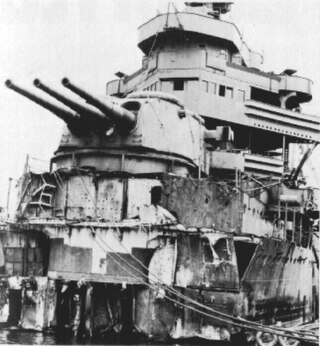
The 8"/55 caliber gun formed the main battery of United States Navy heavy cruisers and two early aircraft carriers. United States naval gun terminology indicates the gun barrel had an internal diameter of 8 inches (203 mm), and the barrel was 55 calibers long.

The BL 8 inch gun Mark VIII was the main battery gun used on the Royal Navy's County-class cruisers, in compliance with the Washington Naval Treaty of 1922. This treaty allowed ships of not more than 10,000 tons standard displacement and with guns no larger than 8 inches (203 mm) to be excluded from total tonnage limitations on a nation's capital ships. The 10,000 ton limit was a major factor in design decisions such as turrets and gun mountings. A similar gun formed the main battery of Spanish Canarias-class cruisers. In 1930, the Royal Navy adopted the BL 6 inch Mk XXIII naval gun as the standard cruiser main battery in preference to this 8-inch gun.
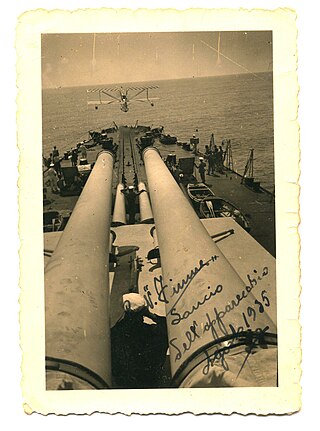
The 203 mm/53 Ansaldo was the main battery gun of Italy's most modern Washington Naval Treaty heavy cruisers. This treaty allowed ships of not more than 10,000 tons standard displacement, and with guns no larger than 8 inches (203 mm), to be excluded from total tonnage limitations on a nation's capital ships.




















